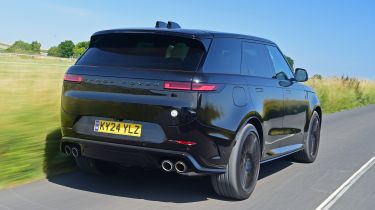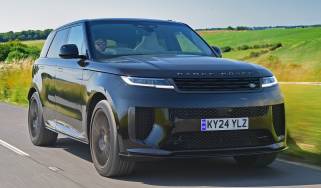Range Rover Sport review – MPG, running costs & CO2
"Opt for a PHEV model, and the Range Rover Sport could be surprisingly affordable to run"
Land Rover started with a clean sheet when it designed the latest Range Rover Sport, allowing for a new range of electrified engines. Every model uses some form of hybrid tech, be it a mild-hybrid or plug-in hybrid system.
Choosing a diesel engine is the cheapest way to get into the Range Rover Sport lineup; the entry-level D250 utilises 48-volt mild hybrid technology to return just under 40mpg on the combined WLTP test cycle. You can get the same diesel engine with more power – badged D300 and D350 – and fuel economy is only negligibly worse.
Those looking to minimise running costs are best off choosing one of the plug-in hybrids, so long as you have access to an EV charger. Badged P460e and P550e, they both use a straight-six petrol engine and deliver impressive economy to match their punchy performance. On paper, the P460e is claimed to return about 388mpg and the P550e up to around 366mpg, but those figures will be unachievable in the real world unless you spend most of your time driving in EV mode.
Speaking of which, every plug-in Range Rover Sport comes fitted with a 38.2kWh battery – that’s one of the largest batteries fitted to a PHEV. This provides a class-leading range of up to 73 miles depending on specification, wheel size and how economically one drives.
More reviews
Car trim reviews
In-depth reviews
- Range Rover Sport review – comfortable and good to drive
- Range Rover Sport PHEV review
- Range Rover Sport PHEV SUV (2013-2022) review
- Range Rover Sport SUV review (2013-2022)
Road tests
Used car reviews
Because the battery is so big, it’ll take a little longer to fully charge than some other PHEVs. Plugging into a 50kW public fast charger will top up the battery to 80% in around 40 minutes, whereas it’ll take around four hours to achieve the same amount of charge when using a 7kW home wall box.
The petrol offerings are by far the least efficient versions of the Range Rover Sport you can go for, and are both powered by a 4.4-litre twin-turbocharged and mild-hybrid assisted V8. The mild-hybrid P530 is the most efficient of the pair – though that’s not saying much – and is capable of up to 24.7mpg with high CO2 emissions of 259g/km. The Range Rover Sport SV takes the gas-guzzling crown, capable of just 23.6mpg and emitting 272g/km of CO2.
Insurance
As you can expect, the Range Rover Sport isn’t cheap to insure – even the entry-level D250 model in base S trim finds itself in insurance group 44 out of 50, while most other models are in the top insurance group.
Servicing
Land Rover recommends you take your Range Rover Sport in for a service every year or 16,000 miles – whichever comes first. Owners can also choose to cover five years of service using a one-off payment.
Warranty
Land Rover covers all of its models for three years with an unlimited mileage warranty. While this tops the likes of Audi with its three-year 60,000-mile warranty, mainstream rivals such as the Kia Sorento boast coverage that spans seven years and 100,000 miles.













